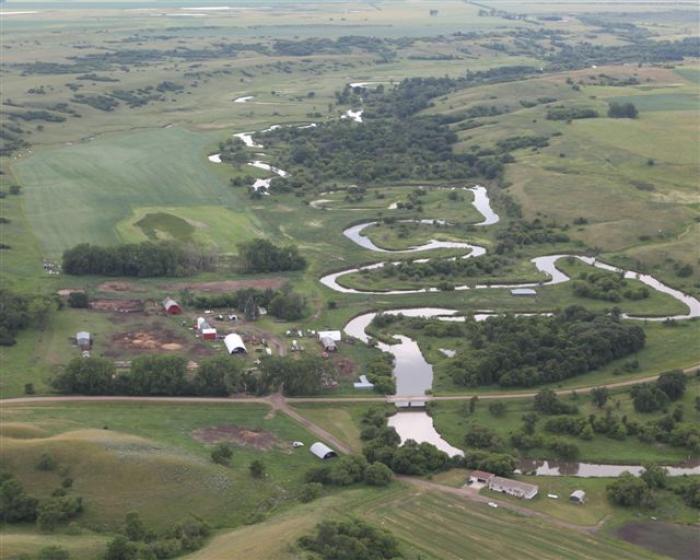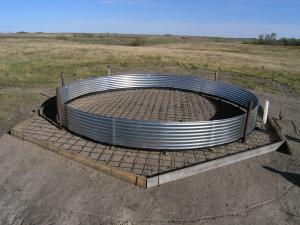Solar Powered Wells Improve Grazing in Eddy County
It’s no surprise to beef producer David Allmaras that cattle need a minimum of 1 to 2 gallons of quality water per 100 pounds of body weight every day. When lactating, cows require twice that much water on a daily basis.

That knowledge, coupled with his lifelong beef production experience and expertise, made it clear to Allmaras that installing new wells on his Eddy County ranch would strengthen the operation’s long-term sustainability. He opted to install two new solar-powered wells at strategic locations to help extend grazing on his grassland and in crop residue.
“We live close to the Sheyenne River, but we’ve had to find water on our hilltops,” Allmaras says. “It isn’t feasible to use electric pumps on these new wells, and electricity would have added an expensive element to our budget.”
Before the wells were installed, cattle on his silage, wheat and oat stubble had to walk as far as two miles to access water.
“And that wasn’t always the best quality water since it was a small pond,” Allmaras says. “Now I know the cattle have all the quality water they need, and I can make better use of crop residue.”
The solar pumps Allmaras installed were designed to use very little energy. Four solar panels on each pump are set at a southern angle to maximize ability to gather solar energy.
Batteries attached to each pump store energy on sunny days, so the pumps have some reserve energy to run during cloudy cycles. He also equipped each pump with a 110-volt gas-operated generator in the event that solar power isn’t available. For the most part, the pumps operate on solar power, keeping one 12,000 gallon tank and one 6,000 gallon tank full every day.
“My tanks are large so that, if we have a day or two when the well isn’t producing at its peak, cattle have some reserve,” Allmaras says.
Allmaras credits his local Natural Resource Conservation Service (NRCS) office with helping him explore his water options and review the feasibility and cost of each alternative.
“I may not have tried any of this without the information my local NRCS office provided,” Allmaras says. “I’m pretty old fashioned and I wouldn’t have had the expertise to understand all my choices and draw up the final equipment plans they provided.”
Don Olds, Eddy County District Conservationist, says Allmaras routinely visits his office to talk about activities on his operation and options and opportunities for enhancing and improving what he’s doing.
“In conversations with producers I start by asking where they’d like to be in 10 years,” Olds says. “That helps identify their production goals and their conservation goals so that we develop their plans accordingly.”
Olds notes that conservation goals don’t need to be met in the span of a year. Taking steps to meet the goal may require several years. The important thing is to look ahead and have a plan in place.
“Dave (Allmaras) is a forward thinker,” Olds says. “He’s always willing to listen and consider new ideas and alternatives. His water project was just one of many conservation plans he’s developed and implemented over the years.”

Over time, Allmaras has installed windbreaks, cross fencing, implemented no-till and diversified his crops.
“Drought conditions have been creeping up on us for a few years now,” Olds says. “Because he was constantly reviewing his operation and looking to the future, Dave had a grazing plan that took drought conditions into consideration.”
In managing conservation practices on his Century Farm, which Olds refers to as a “slice of paradise” on the river bottom, Allmaras is providing wildlife habitat and improving soil quality. In addition to no-till practices, Allmaras is using cover crops to help build soil organic matter and keep soil biology active each season for as long as possible.
“Mother Nature threw a lot of curves at us this year. It was so dry many cover crops around the county didn’t even germinate,” Olds says. “With heavy late winter storms and severe summer storms, we lost a lot of trees in the county too.”
In working with Eddy County producers, Olds and his experienced staff assist in identifying appropriate conservation plans, exploring funding options and help producers pencil out costs and benefits. The Allmaras family recognized an opportunity for significant savings by opting to work together to pour concrete foundations for water tanks and recycle a grain bin to serve as one of the tanks.
“Drilling the well was our biggest expense,” Allmaras says. “We’ll drain tanks late in the fall and won’t use the wells over winter because there would be too many issues with freezing water. Even at that, we’ll let our cattle graze further into the fall than we used to, and this helps us reduce our overall winter feeding bill.”
In reviewing the economic aspects of the new wells, Allmaras recognized that he’s able to garner more value out of each acre of his operation by keeping cattle on grassland and crop residue for a greater number of days.
“As we see how it all works, I will consider planting more small grains to help extend my grazing season,” Allmaras says. “Since the water is accessible from three different grazing cells, it significantly expands our grazing options. Cattle are likely to graze areas more thoroughly now, too, since they don’t have to travel so far to get a drink.”
Olds recommends that producers regularly interact with NRCS staff in order to maximize operations and stay informed about options for boosting their operation’s production and stability.
“Dave’s overall goal is to make his operation better for his sons when they take it over, just as he took over for his father,” Olds says. “He’s well on his way to reaching his goals.”

